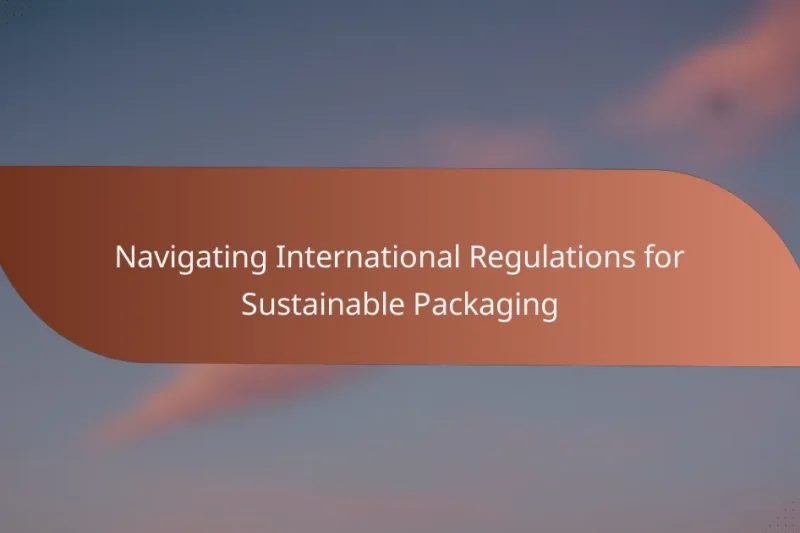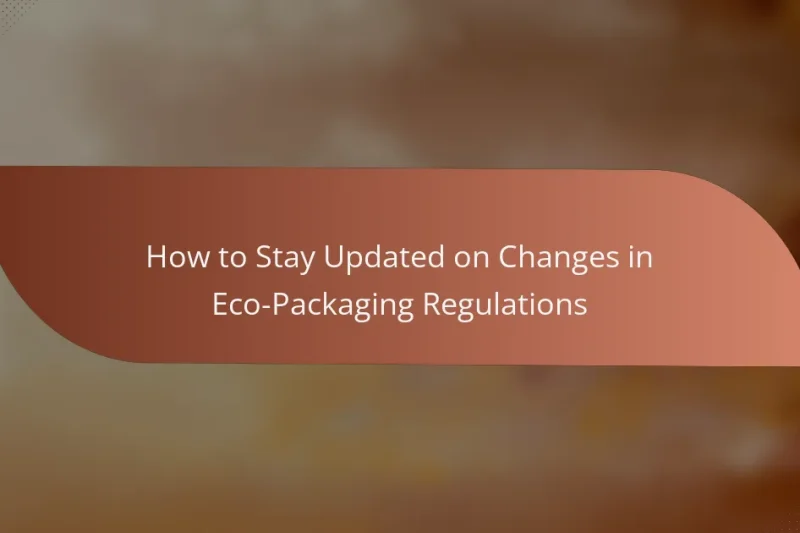Navigating international regulations for sustainable packaging is crucial for businesses seeking to minimize their environmental impact … Navigating International Regulations for Sustainable PackagingRead more
Eco-Conscious Gift Packaging Services: Regulatory Compliance
Eco-conscious gift packaging services play a crucial role in promoting sustainability while adhering to environmental regulations in the US. These services focus on using materials that are biodegradable, recyclable, and compostable, ensuring compliance with eco-friendly standards. By selecting suppliers committed to sustainable practices, businesses can enhance their brand perception and appeal to environmentally conscious consumers.
How to Stay Updated on Changes in Eco-Packaging Regulations
Staying updated on eco-packaging regulations is essential for e-commerce businesses to remain compliant and competitive. By … How to Stay Updated on Changes in Eco-Packaging RegulationsRead more
Understanding Packaging Regulations for Eco-Conscious Businesses
Understanding packaging regulations is crucial for eco-conscious businesses aiming to promote sustainability while ensuring compliance with … Understanding Packaging Regulations for Eco-Conscious BusinessesRead more
What eco-conscious gift packaging services comply with regulations in the US?
Eco-conscious gift packaging services in the US must adhere to various environmental regulations while offering sustainable options. Compliance typically involves using materials that meet standards for biodegradability, recyclability, and compostability.
Biodegradable packaging options
Biodegradable packaging is designed to break down naturally over time, reducing waste in landfills. Common materials include plant-based plastics, paper, and certain types of foams. When selecting biodegradable options, ensure they meet ASTM D6400 or D6868 standards for biodegradability.
Consider the end-use of the packaging; for instance, if it will be exposed to moisture, choose materials that can withstand such conditions while still being biodegradable. Always check for certifications to confirm compliance with environmental regulations.
Recyclable materials
Recyclable packaging materials can be processed and reused, minimizing environmental impact. Common recyclable materials include cardboard, glass, and certain plastics marked with recycling symbols. To ensure compliance, verify that the materials are accepted by local recycling programs.
When designing gift packaging, aim for materials that are easy to separate and sort, as this enhances the likelihood of recycling. Avoid mixing materials that cannot be recycled together, as this can lead to contamination and increased waste.
Certified compostable packaging
Certified compostable packaging breaks down into non-toxic components in a composting environment. Look for certifications such as BPI or DIN Certco, which indicate compliance with composting standards. These materials often include plant-based plastics and paper products.
When using compostable packaging, provide clear instructions for disposal to ensure it reaches the appropriate composting facility. Avoid using compostable materials in environments where they cannot break down effectively, such as traditional landfills.
How to choose eco-friendly packaging services?
To choose eco-friendly packaging services, prioritize suppliers that use sustainable materials and demonstrate commitment to environmental practices. Look for certifications and transparency in their operations to ensure compliance with eco-friendly standards.
Evaluate material certifications
When selecting eco-friendly packaging, check for certifications that validate the sustainability of the materials used. Look for labels such as FSC (Forest Stewardship Council) for paper products or biodegradable certifications for plastics. These certifications indicate adherence to environmental standards and responsible sourcing.
Additionally, consider the lifecycle of the packaging materials. Products that are recyclable or compostable can significantly reduce environmental impact. Always ask suppliers for documentation of their certifications to ensure authenticity.
Assess supplier sustainability practices
Investigate the sustainability practices of potential packaging suppliers. This includes their waste management strategies, energy usage, and overall carbon footprint. Suppliers who invest in renewable energy or have a clear plan for reducing waste are often more committed to eco-friendly practices.
Furthermore, evaluate their supply chain transparency. A supplier that openly shares information about their sourcing and production processes is likely to be more reliable. Look for partnerships with organizations that promote sustainability, as these can be indicators of a supplier’s dedication to eco-conscious practices.
What are the benefits of eco-conscious gift packaging?
Eco-conscious gift packaging offers several advantages, including improved brand perception and a positive impact on the environment. By choosing sustainable materials and practices, businesses can attract environmentally aware consumers and contribute to a healthier planet.
Enhanced brand reputation
Utilizing eco-conscious gift packaging can significantly enhance a brand’s reputation. Consumers increasingly prefer brands that demonstrate environmental responsibility, which can lead to increased loyalty and trust. For example, companies that use recyclable or biodegradable materials often receive favorable attention in marketing and social media.
To maximize this benefit, clearly communicate your sustainable practices on packaging and marketing materials. Transparency about sourcing and production processes can further strengthen consumer confidence in your brand.
Reduced environmental impact
Eco-conscious gift packaging helps reduce the overall environmental impact of product packaging. By opting for materials that are recyclable, compostable, or made from recycled content, businesses can minimize waste and lower their carbon footprint. This shift not only benefits the environment but can also lead to cost savings in waste management.
Consider implementing a take-back program for packaging or encouraging customers to reuse materials. These practices not only promote sustainability but also engage customers in your eco-friendly mission, fostering a community around your brand.
What regulations affect eco-conscious packaging in the US?
In the US, eco-conscious packaging is influenced by various regulations that ensure environmental protection and consumer safety. Key regulations include guidelines from the Federal Trade Commission and state-specific laws that govern packaging materials and labeling practices.
Federal Trade Commission guidelines
The Federal Trade Commission (FTC) provides guidelines that require businesses to avoid misleading claims about the environmental benefits of their packaging. Companies must substantiate any eco-friendly claims, such as “biodegradable” or “recyclable,” with evidence to support their accuracy.
To comply with FTC guidelines, businesses should clearly define terms used in their marketing and ensure that any environmental claims are specific and not vague. For example, stating that a product is “made with recycled materials” should be backed by clear percentages of recycled content.
State-specific packaging laws
Many states have enacted their own packaging laws that may impose stricter requirements than federal guidelines. For instance, California has laws that restrict certain chemicals in packaging and mandate labeling for recyclable materials. Businesses operating in multiple states must be aware of these variations to ensure compliance.
To navigate state-specific laws effectively, companies should conduct thorough research on the regulations in each state where they sell products. This may involve consulting legal experts or industry associations to stay updated on changes and best practices.
How to ensure compliance with eco-packaging regulations?
To ensure compliance with eco-packaging regulations, businesses must understand the specific requirements that govern sustainable packaging in their region. This includes adhering to environmental standards, using recyclable materials, and maintaining transparency in sourcing and disposal practices.
Regular audits of packaging suppliers
Conducting regular audits of packaging suppliers is essential for maintaining compliance with eco-packaging regulations. These audits should assess the sustainability practices of suppliers, including their material sourcing, production processes, and waste management strategies.
Establish a checklist for audits that includes criteria such as certifications (e.g., FSC, ISO 14001), material recyclability, and adherence to local regulations. This proactive approach helps identify potential compliance gaps before they become issues.
Staying updated on regulatory changes
Staying informed about regulatory changes is crucial for businesses involved in eco-packaging. Regulations can vary significantly by country and may evolve frequently, so it is important to monitor updates from relevant authorities and industry associations.
Consider subscribing to newsletters from environmental agencies or joining industry groups that focus on sustainable practices. This will help ensure that your packaging strategies remain compliant and aligned with best practices in sustainability.
What are the costs associated with eco-conscious gift packaging?
The costs associated with eco-conscious gift packaging can vary widely based on materials, production methods, and shipping logistics. Businesses should anticipate both initial investments and ongoing expenses to ensure compliance with environmental standards while meeting customer expectations.
Material sourcing costs
Material sourcing costs for eco-friendly packaging often exceed those of conventional options due to the premium nature of sustainable materials. Common choices include recycled paper, biodegradable plastics, and organic fabrics, which can range from slightly higher to significantly more expensive than traditional materials.
When selecting materials, consider local suppliers to reduce transportation costs and support regional economies. Bulk purchasing can also help lower per-unit costs, making it easier to manage budgets while maintaining sustainability goals.
Production and shipping expenses
Production expenses for eco-conscious gift packaging can be higher due to specialized manufacturing processes and lower economies of scale. Depending on the complexity of the design and the materials used, businesses may see production costs increase by 10-30% compared to standard packaging.
Shipping expenses can also be impacted by the weight and bulk of eco-friendly materials. It’s essential to balance the choice of sustainable packaging with shipping efficiency to avoid excessive costs. Using lightweight materials and optimizing package sizes can help mitigate these expenses while staying true to eco-conscious principles.


